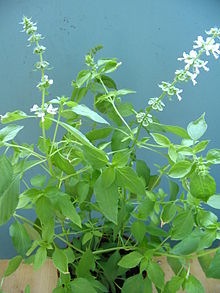- Lemon basil
-
Lemon basil 
Scientific classification Kingdom: Plantae (unranked): Angiosperms (unranked): Eudicots (unranked): Asterids Order: Lamiales Family: Lamiaceae Genus: Ocimum Species: O. × citriodorum Binomial name Ocimum × citriodorum
Vis.Lemon basil (Ocimum × citriodorum) is a hybrid between basil (Ocimum basilicum) and African basil (Ocimum americanum).
It is an herb grown primarily in northeastern Africa and southern Asia, for its strong fragrant lemon scent is used in cooking.
Lemon basil has stems that can grow to 20-40 cm tall. It has white flowers in late summer to early fall. The leaves are similar to basil leaves, but tend to be narrower. Seeds form on the plant after flowering and dry on the plant.
Lemon basil is a popular herb in Arabic, Indonesian, Lao, Persian, and Thai cuisine.
Contents
Culinary uses
It is the only basil that is much used in Indonesian cuisine where it is called kemangi. It is often eaten raw with salad or lalap (raw vegetables) and accompanied by sambal. To season certain Indonesian curries, grilled, steamed, soup and stew dishes, lemon basil is often used.
In Laos, lemon basil is typically used in certain Lao curries, stews, and stir-fried dishes.[1][2]
In Thailand, lemon basil is called maenglak (Thai: แมงลัก) and it is one of several types of basil used in Thai cuisine. The leaves are used in certain curries and it is also indispensable for the noodle dish Khanom chin nam ya. The seeds resemble frog's eggs after they have been soaked in water and are used in sweet desserts.
Cultivation
Lemon basil requires the same care as other basil varieties. Being a tropical plant it should be in a spot receiving at least six hours of direct sunlight. It is actually quite hardy and will grow continuously given only water, but flavor will be at risk if not given any fertilizer, chemical or organic. It can really grow in a matter of weeks. The only pointer to remember about watering is it should be watered whenever the topmost part of the soil is dry. At this time the plant will wilt, but will be back to normal once watered.
Basil should never reach flowering during the harvesting periods. If given a chance to flower, its flavor will be sacrificed and the leaves become smaller and rather leathery. Once the flower clusters form, they should be removed so that the plant will continue its vegetative growth. It is, however, a good idea for it to be left to flower and set seeds that will be collected during fall, because the cold winter frosts will kill the basil plant anyway so sowing the seeds 2 weeks indoors before the last frost will provide next year's harvest.
Harvesting once a week for each plant will make it bushy due to the side shoots that will develop. The plant should never be completely defoliated. Propagation is achieved by sowing seeds and from stem cuttings. Seedlings will reach six inches in 3-4 weeks and should be harvested at this time to let them branch out. Stem cuttings will gain roots after a week of being soaked in water. The setup is simply a Mason jar filled with water and a square of mesh with big enough holes to hold the plant in place while the roots grow. As many cuttings as the gardener wishes can be planted, preferably the most vigorous stems that can be found because they will root faster. The water should be changed every few days. After 2-3 weeks, the roots will be long enough for the cuttings to be transplanted into pots or planted in their permanent position in the garden.
References
External links
Categories:- Lamiaceae
- Herbs
- Lao ingredients
- Thai ingredients
- Lamiaceae stubs
Wikimedia Foundation. 2010.
